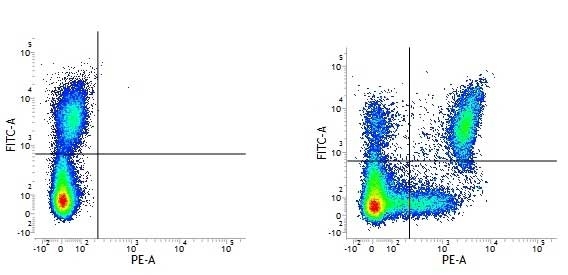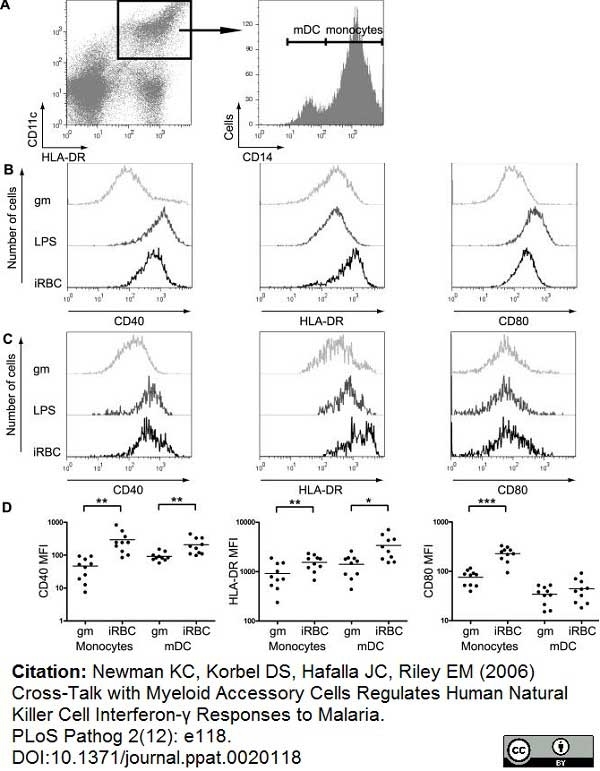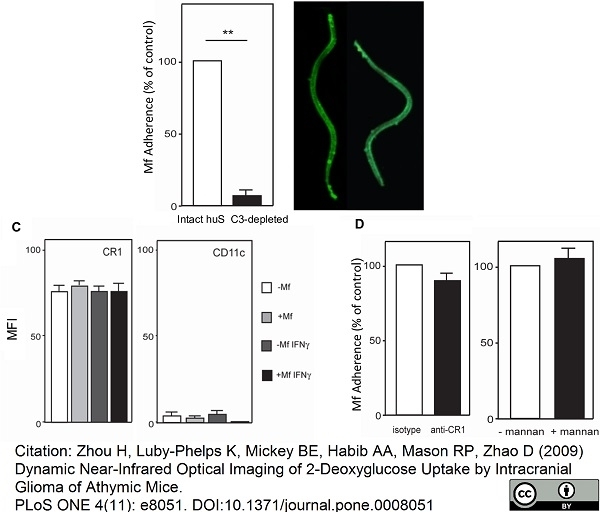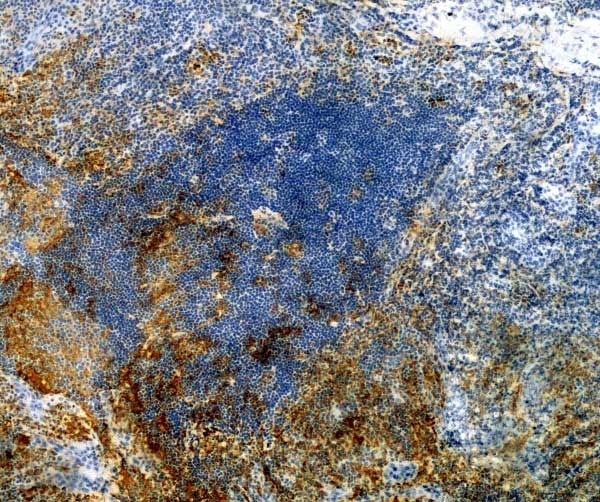CD11c antibody | BU15




Mouse anti Human CD11c
- Product Type
- Monoclonal Antibody
- Clone
- BU15
- Isotype
- IgG1
- Specificity
- CD11c
| Mouse anti Human CD11c antibody, clone Bu15 recognizes the integrin alphax subunit (ITGAX), a ~150 kDa glycoprotein also known as CD11 antigen-like family member C or Leu M5, CD11c is expressed by macrophages, monocytes, NK cells and most dendritic cells (Kohrgruber et al. 1999). CD11c is also expressed at a lower level by granulocytes. CD11c forms a heterodimeric integral membrane protein with the integrin beta 2 chain to form the leukocyte specific integrin 'inactivated-C3b receptor 4'. CD11c interacts with a number of ligands including the G-P-R sequence in fibrinogen, ICAM-1 (Frick et al. 2005), iC3b ( CD11c is expressed by hairy cell leukaemia cells (Goodman et al. 2003; Nicolaou et al. 2003). |
- Target Species
- Human
- Species Cross-Reactivity
-
Target Species Cross Reactivity Cynomolgus monkey - N.B. Antibody reactivity and working conditions may vary between species.
- Product Form
- Purified IgG - liquid
- Preparation
- Purified IgG prepared from tissue culture supernatant
- Buffer Solution
- Phosphate buffered saline
- Preservative Stabilisers
- 0.09% sodium azide (NaN3)
- Carrier Free
- Yes
- Approx. Protein Concentrations
- IgG concentration 1.0 mg/ml
- Regulatory
- For research purposes only
- Guarantee
- 12 months from date of despatch
Avoid repeated freezing and thawing as this may denature the antibody. Storage in frost-free freezers is not recommended.
| Application Name | Verified | Min Dilution | Max Dilution |
|---|---|---|---|
| Flow Cytometry | 1/10 | 1/50 | |
| Immunohistology - Frozen 1 | |||
| Immunohistology - Paraffin | |||
| Immunoprecipitation |
- 1The epitope recognised by this antibody is reported to be sensitive to formaldehyde fixation and tissue processing. Bio-Rad recommends the use of acetone fixation for frozen sections.
- Flow Cytometry
- Use 10μl of the suggested working dilution to label 106 cells in 100μl
| Description | Product Code | Applications | Pack Size | List Price | Your Price | Quantity | |
|---|---|---|---|---|---|---|---|
| Mouse IgG1 Negative Control | MCA928 | F | 100 Tests |
|
Log in | ||
| List Price | Your Price | ||||||
|
|
Log in | ||||||
| Description | Mouse IgG1 Negative Control | ||||||
References for CD11c antibody
-
Hogg, N. et al. (1986) The p150,95 molecule is a marker of human mononuclear phagocytes: comparison with expression of class II molecules.
Eur J Immunol. 16 (3): 240-8. -
Levy, O. et al. (2003) Critical role of the complement system in group B streptococcus-induced tumor necrosis factor alpha release.
Infect Immun. 71: 6344-53. -
Newman, K.C. et al. (2006) Cross-talk with myeloid accessory cells regulates human natural killer cell interferon-gamma responses to malaria.
PLoS Pathog. 2: e118. -
Brown, D.P. et al. (2009) The inhibitory receptor LILRB4 (ILT3) modulates antigen presenting cell phenotype and, along with LILRB2 (ILT4), is upregulated in response to Salmonella infection.
BMC Immunol. 10: 56. -
Silk, K.M. et al. (2012) Rapamycin conditioning of dendritic cells differentiated from human ES cells promotes a tolerogenic phenotype.
J Biomed Biotechnol. 2012:172420. -
Herman, S. et al. (2012) Regulatory T cells form stable and long-lasting cell cluster with myeloid dendritic cells (DC).
Int Immunol. 24 (7): 417-26. -
Xie, Z. et al. (2016) Human umbilical cord-derived mesenchymal stem cells elicit macrophages into an anti-inflammatory phenotype to alleviate insulin resistance in type 2 diabetic rats.
Stem Cells. 34 (3): 627-39. -
Schroeder JH et al. (2017) Brugia malayi microfilariae adhere to human vascular endothelial cells in a C3-dependent manner.
PLoS Negl Trop Dis. 11 (5): e0005592.
View The Latest Product References
-
Simões, R.D. et al. (2019) Effects of Regulatory T Cell Depletion on NK Cell Responses against Listeria monocytogenes in Feline Immunodeficiency Virus Infected Cats.
Viruses. 11 (11)Oct 24 [Epub ahead of print].
Further Reading
-
Larson, R.S. & Springer, T.A. (1990) Structure and function of leukocyte integrins.
Immunol Rev. 114: 181-217. -
Loike, J.D. et al. (1991) CD11c/CD18 on neutrophils recognizes a domain at the N terminus of the A alpha chain of fibrinogen.
Proc Natl Acad Sci U S A. 88 (3): 1044-8. -
Sanchez-Madrid, F. and Corbi, A.L. (1992) Leukocyte integrins: structure, function and regulation of their activity.
Seminars Cell Biol. 3: 199-210.
- Synonyms
- Integrin Alpha X Chain
- RRID
- AB_323659
- UniProt
- P20702
- Entrez Gene
- ITGAX
- GO Terms
- GO:0005515 protein binding
- GO:0007596 blood coagulation
- GO:0007155 cell adhesion
- GO:0004872 receptor activity
- GO:0008305 integrin complex
- GO:0007229 integrin-mediated signaling pathway
- GO:0009887 organ morphogenesis
- GO:0050900 leukocyte migration
MCA2087
If you cannot find the batch/lot you are looking for please contact our technical support team for assistance.
Please Note: All Products are "FOR RESEARCH PURPOSES ONLY"
View all Anti-Human ProductsAlways be the first to know.
When we launch new products and resources to help you achieve more in the lab.
Yes, sign me up


